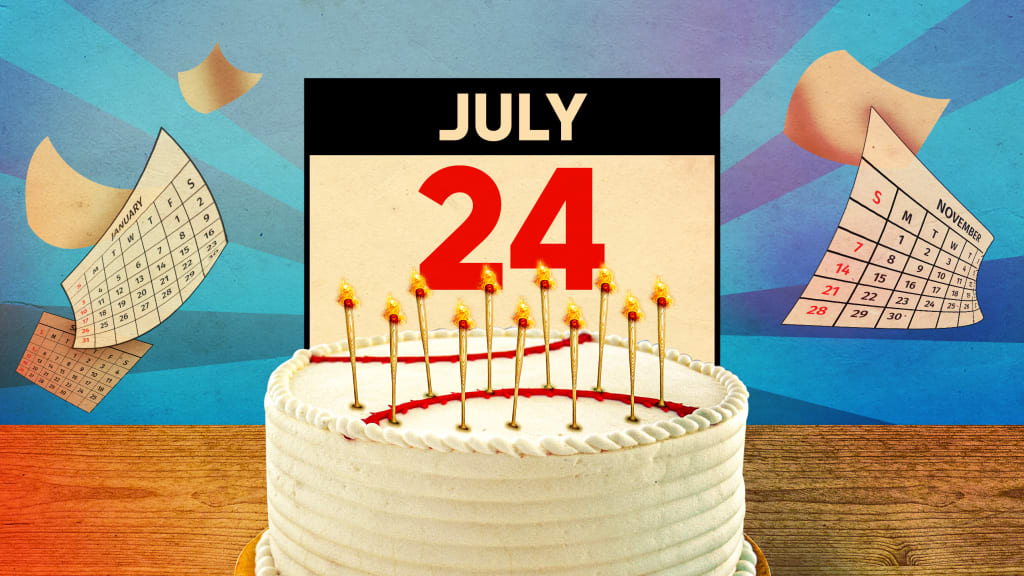
Who are the best players born on each day of the year? We have a list for every day on the calendar.
Here’s a subjective ranking of the top five for July 24. (Note: No. 1 wasn't a difficult choice.)
1) Barry Bonds (1964)
Early in the morning on Aug. 8, 2007, the East Coast was suddenly pounded by a flash storm of biblical proportions. Up to four inches of rain dropped in a two-hour span, flooding the vaunted New York City subway system and knocking it off the grid for around 8 hours, including morning rush hour. Meanwhile, the outer boroughs dealt with flash tornadoes.
"It started raining really hard," said then-NYC Transit president Elliot Sander, "which was not predicted."
The sudden deluge might have just been one of those random things; meteorologists are sharp, but they’re not omniscient.
That said, could it have actually been a classic example of the butterfly effect? Mere hours before the storm, Barry Bonds uncorked a seismic swing that rippled through the baseball landscape. Did it also roil weather patterns all the way across the country?
Well … probably not. But regardless of his ability to manipulate the weather -- or lack thereof -- Bonds’ fifth-inning home run off Washington's Mike Bacsik was the landmark 756th of his career, allowing him to surpass Hank Aaron for the most in baseball history. The feat itself is polarizing, much like the man who achieved it. But it remains a fitting final flourish for one of the most talented -- and enigmatic -- men to ever play the game.
Barry’s talent was not just cultivated, but inherited and bestowed; his father was three-time All-Star Bobby Bonds, while his godfather was Willie Mays, one of the greatest players ever. Barry Bonds starred at Arizona State, and then was drafted by the Pirates sixth overall in the 1985 Draft.
Bonds rapidly developed into a supreme power-speed threat, winning 2 NL MVP Awards in 3 seasons for the Bucs from 1990-92; he finished second to Atlanta’s Terry Pendleton in '91. Following the '92 season, he departed Pittsburgh for the Giants, with whom he became a Bay Area icon.
Among his exploits for the Giants, Bonds:
• Hit a single-season record 73 home runs in 2001.
• Led the Giants to the 2002 World Series, and Bonds hit .471 with four homers and 13 walks in a losing effort. (The Giants lost in seven games to the Angels.)
• Set MLB records with a’ .609 on-base percentage and 232 walks in 2004.
The paradox with Bonds is that while he was one of the most thrilling players to watch, he was also the most polarizing. He famously self-isolated with a $3,000 lounge chair, multiple lockers and his own personal television in the clubhouse. He was loath to talk to the media. And his wondrous feats over the second half of his career were accompanied by allegations of performance-enhancing drug use. All of this greatly affected his Hall of Fame candidacy.
The fact remains, however: Bonds was one of the most exciting players in the history of the game. Look no further than his iconic Yankee Stadium homer -- “This one is headed for New Jersey!” Even simply watching Bonds work a walk was fascinating, as he unflinchingly took pitches centimeters off the plate, shedding his elbow armor for his routine trots to first base even before the pitch hit the catcher’s glove.
Bonds also seemed to soften and mellow a bit following his playing career. He paid for Bryan Stow’s children’s education after Stow was beaten badly in a Dodger Stadium parking lot, mentored a women’s cycling team and relished spending time with his grandkids.
All in all, Bonds lived a fascinating life entirely in the spotlight, and excelled at his sport in a way that very few ever have. Hate him or love him, you won’t soon forget him.
2) Tommy McCarthy (1863)
Despite a relatively unfamiliar name and a somewhat pedestrian career spent playing for a host of now-defunct teams in the 19th century, McCarthy has a plaque in the Hall of Fame courtesy of the Veterans Committee. His 16.2 WAR in 13 seasons doesn't quite leap off the page on Baseball Reference, though his speed (468 steals) and cannon arm (266 assists) were considerable strengths.
McCarthy's main contribution was his ingenuity. Paired with friend and fellow Hall of Famer Hugh Duffy on the Boston Beaneaters, he was suitably inspired and later credited for innovating the hit and run. (The two also co-owned a saloon/bowling alley.) As such, "Mac" is in the Hall of Fame not necessarily for what he did on the field, but rather for his impact on the game's strategies for centuries to come.
3) Jack Clements (1864)
Relatively little is known about Clements, a standout catcher from the 19th century. But there are a few quirks that make him stand out.
For one, his 26.8 WAR places him second -- a distant one, but still -- behind Bonds among players born on July 24. He was known as an innovator: A rare left-handed catcher, his glove was certainly unique, described as "straight as a shingle," in order to have the pitch bounce directly into his other hand. And for at least a while, he used a chest protector that he had to blow up before every game.
Clements was also said to be one of the first victims of the Philadelphia fans -- known as the Boo Birds -- though he'd hardly be the last.
4) Dick Higham (1851)
Higham was notable for a few things: He was born in England, his father was a famed cricket player and he would umpire games that his team was involved with. This wasn't uncommon in that day and age, though Higham was ultimately -- and somewhat unsurprisingly -- summarily banned from umpiring National League games.
It was largely assumed Higham's sanction had something to do with gambling, as it happened right after umpires were forbidden from betting on games for the first time. Higham, for his part, denied the accusations.
Nonetheless, Higham's 7.0 WAR ranked fourth among all players born on this date.
5) Duane Pillette (1922)
Pillette was a pitcher of some renown; he won 10 games twice and had a 4.40 career ERA. But his career is largely defined by ephemera. Pillette could easily be a contest-winning answer on Trivia Night for a number of things:
• He was the pitcher for the St. Louis Browns in the game when 3-foot-7 Eddie Gaedel pinch-hit.
• He started the final game the Browns played in St. Louis before moving to Baltimore and becoming the Orioles.
• He was the winning pitcher in the Orioles' first victory.
• He and his father, Herman, were the only father-son combination to both lead the Majors in defeats.
Want to see more baseball birthdays for July 24? Find the complete list on Baseball Reference.
